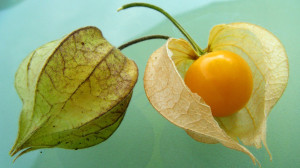 Goldenberry
Goldenberry
(Physalis peruviana)
The Goldenberry is native to the South American Andes mountains, from Chile to Colombia.
The small, golden fruits have papery husks that turn brown when the fruits ripen. They have a sweet-tart, citrus/pineapple/vanilla flavour. They ripen to a beautiful a golden-orange colour and if picked carefully with the calyx intact, the fruit can be stored for 3 months or more.
With their high pectin content, Goldenberries can be eaten fresh or dried, or made into jams, jellies, purées and pies. They are delicious in over ice cream or in fresh fruit salads. The dried fruits can be used as a substitute for raisins, though they are not as sweet. They can be used in exotic fruit salads, pavlovas or roulades, or simmered in water with a little sugar and used in fruit pies or crumbles.
The Goldenberry is rich in vitamin A, vitamin C and some of the B complex (thiamine, niacin and B12) vitamins. The protein and phosphorus levels are exceptionally high for a fruit. 
The flowers are beautiful before they turn into fruit. They are called ‘Lampion’ flowers in German because they look like lanterns.
In Italy they are sold chocolate covered in confectionery shops (=pasticcerie). Goldenberries are sold all over Germany. Quartered “cape gooseberries” are mixed into a delicious ramps (wild garlic) pesto, which is poured over pasta. Goldenberries are also a great accent to bitter salads, like endive or arugula.
Recipe: Festive fruit salad with brandy snap
This amazing fruit is also known as
• Cape Gooseberry (South Africa)
• Inca Berry
• Aztec Berry
• Giant Ground Cherry
• African Ground Cherry
• Peruvian Groundcherry
• Peruvian Cherry
• Pok Pok (Madagascar)
• Poha (Hawaii)
• Ras Bhari (India)
• Aguaymanto (Peru
• Uvilla (Ecuador)
• Uchuva/Ochuva (Colombia)
• Harankash (Egypt)
• Amour en Cage (France, French for ‘Love in a Cage’)
• and sometimes simply Physalis (United Kingdom)

